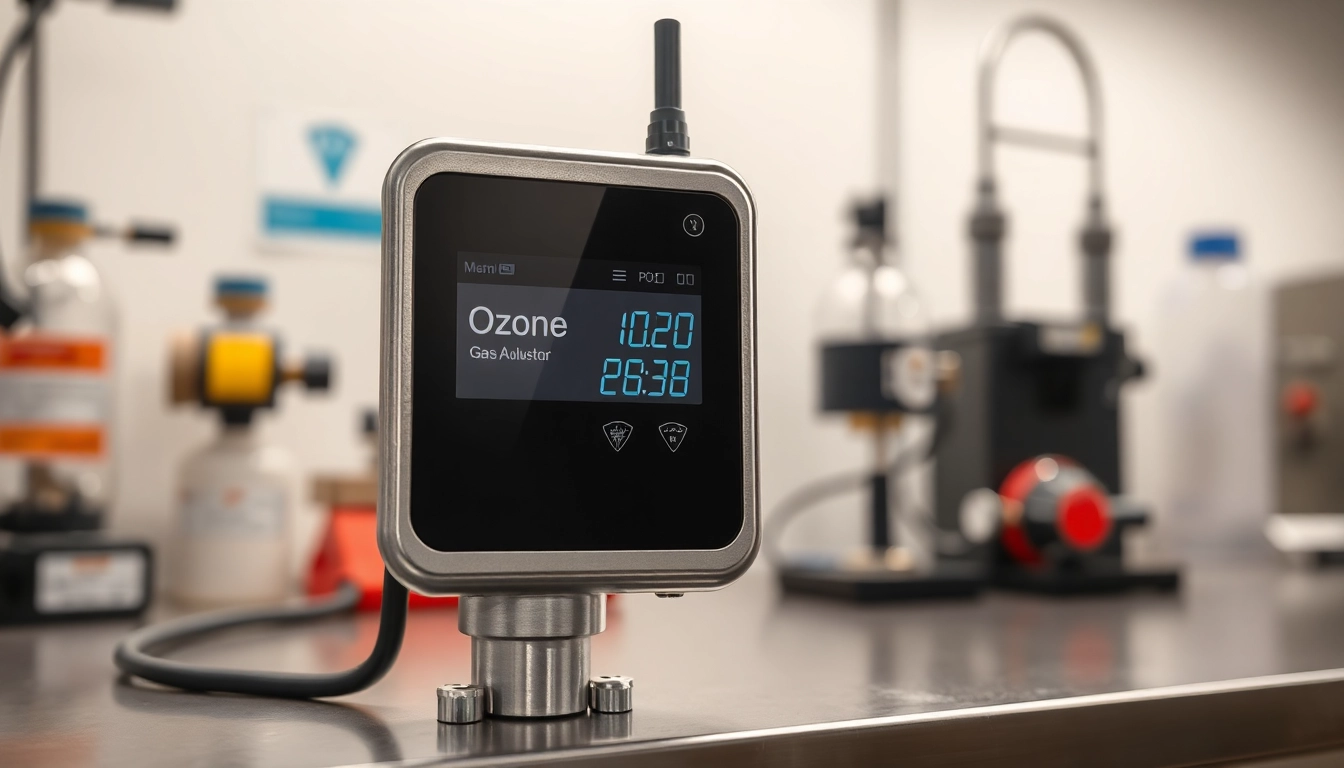Understanding Ozone and Its Risks
What is Ozone and How is it Formed?
Ozone (O3) is a colorless gas comprised of three oxygen atoms, naturally occurring in the Earth’s stratosphere. It plays a crucial role in protecting living organisms by absorbing the majority of the sun’s harmful ultraviolet radiation. However, ground-level ozone, which is formed when sunlight reacts with pollutants such as volatile organic compounds (VOCs) and nitrogen oxides (NOx), is a significant air pollutant and can cause various health and environmental issues. Understanding the formation of ozone and the conditions that lead to high levels of ground-level ozone is essential, especially for industries that may expose workers to this gas.
Health Effects of Ozone Exposure
Exposure to elevated ozone levels can lead to various health problems. Short-term exposure may result in respiratory issues, such as coughing, throat irritation, and shortness of breath. More severe cases can exacerbate existing lung diseases such as asthma and lead to increased susceptibility to other respiratory infections. Long-term exposure has been associated with chronic respiratory diseases and can affect lung function over time. Vulnerable populations, including children, the elderly, and those with pre-existing health conditions, are particularly at risk. Therefore, monitoring ozone levels is vital for ensuring public health and safety.
Regulatory Standards for Ozone Levels
In the United States, the Environmental Protection Agency (EPA) sets regulatory standards for ground-level ozone under the Clean Air Act. The current standard is 70 parts per billion (ppb) averaged over eight hours. These regulations aim to minimize health risks associated with ozone exposure and promote cleaner air. Many other countries have similar standards in place, emphasizing the global recognition of ozone’s harmful effects. Compliance with these standards is essential for industries and municipalities, driving the demand for effective ozone gas detectors in workplaces and urban environments.
Choosing the Right Ozone Gas Detector
Types of Ozone Detectors: Pros and Cons
Ozone gas detectors come in several types, each with advantages and disadvantages. The primary types include:
- Chemical Sensor Detectors: These detectors utilize a chemical reaction to measure ozone concentrations. They are typically cost-effective and straightforward to use. However, they may have a limited lifespan and can be less accurate at low ozone levels.
- Electrochemical Detectors: These devices measure ozone through electrochemical cells, offering high sensitivity and specificity. They are suitable for continuously monitoring ozone levels but can be affected by temperature and humidity.
- Photoionization Detectors (PID): These detectors use ultraviolet light to ionize ozone molecules, enabling highly precise measurements. They are generally more expensive and require regular calibration but offer excellent sensitivity to ozone.
Key Features to Look for in Ozone Gas Detectors
When selecting an ozone gas detector, it’s essential to consider specific features that can impact its effectiveness. Key features to look for include:
- Accuracy and Sensitivity: The detector should provide precise readings of ozone levels to ensure safety and compliance with regulations.
- Response Time: Quick response times are crucial for detecting sudden spikes in ozone levels, allowing for immediate intervention.
- Portability: Consider whether a portable detector is necessary for your applications, especially for outdoor or fieldwork scenarios.
- Alarm Features: Look for visual and auditory alarms that alert users when ozone concentrations exceed safety thresholds.
How to Assess Detector Accuracy and Reliability
Assessing the accuracy and reliability of an ozone gas detector is critical for ensuring effective monitoring. Some methods include:
- Calibration: Regular calibration against known ozone standards is essential to maintain measurement accuracy. Always follow the manufacturer’s guidelines for calibration frequency.
- Field Testing: Conduct field tests alongside other detection methods to verify the readings of your ozone detector.
- User Reviews and Certifications: Consider detectors with relevant certifications and positive user reviews, as these often indicate reliability and performance under real-world conditions.
Installing Your Ozone Gas Detector
Best Practices for Detector Placement
Proper installation of ozone gas detectors is vital for accurate measurements. The following best practices should be considered:
- Location: Install detectors in areas where ozone is likely to accumulate, such as near ventilation systems or manufacturing processes that emit ozone.
- Height: Mount the detector at breathing height (about 4-5 feet off the ground) to ensure it accurately measures the air inhaled by people.
- Distance from Sources: Place detectors a safe distance away from operation sources to avoid false readings caused by local ozone hotspots.
Step-by-Step Installation Guide
To install your ozone gas detector effectively, follow these steps:
- Identify the installation location based on the best practices outlined.
- Ensure the necessary tools are available, including mounting hardware and any required calibration equipment.
- Install the mounting bracket according to the manufacturer’s specifications, ensuring it is secure and at the proper height.
- Attach the ozone detector to the mounting bracket and connect it to power or, if applicable, battery sources.
- Run initial tests to check the functionality of the detector, ensuring it is operating within expected parameters.
Integrating Detectors with Existing Safety Systems
To enhance workplace safety, integrating ozone detectors with existing safety systems, such as alarm systems and ventilation controls, is highly beneficial. Consider the following integration strategies:
- Alarm System Integration: Connect the ozone detector to an existing alarm system to ensure immediate alerts in case of high ozone levels.
- Ventilation Control: Automate ventilation systems to respond to elevated ozone levels, improving air quality and safety.
- Data Logging Systems: Use software to collect data from multiple detectors for comprehensive monitoring and analysis over time.
Maintaining Your Ozone Gas Detector
Regular Calibration and Testing
Regular calibration and testing are critical for ensuring the longevity and reliability of ozone gas detectors. Follow these guidelines:
- Calibration Schedule: Adhere to a strict calibration schedule, typically every 6 to 12 months, depending on the manufacturer’s recommendations and usage conditions.
- Testing Procedures: Implement routine testing procedures that mimic real-world conditions to verify detector performance.
- Documentation: Keep detailed calibration and testing records for compliance and to track detector performance over time.
Troubleshooting Common Issues
Here are common issues with ozone detectors and troubleshooting steps:
- False Readings: If the detector provides inconsistent readings, check for environmental factors such as humidity and temperature that may affect performance.
- Alarm Failure: If the alarms do not trigger when expected, inspect the alarm settings and test functionality regularly.
- Power Issues: In case of power-related problems, ensure that the connections are secure and that batteries are charged if applicable.
When to Replace Your Ozone Gas Detector
Awareness of when to replace the ozone gas detector is crucial for maintaining safety standards. Consider replacing the detector if:
- Age: Many detectors have a limited operational life, typically around 2 to 5 years. Review the manufacturer’s guidelines for replacement timelines.
- Frequent Calibrations: If calibration becomes increasingly difficult, it might be an indicator of degradation and the need for a new device.
- Outdated Technology: Rapid advancements in detection technology can render older models less effective or unsafe; consider upgrading for better performance.
Case Studies: Effectiveness of Ozone Gas Detectors
Success Stories in Industrial Environments
Many industries have benefited from the implementation of ozone gas detectors. For example, in manufacturing facilities where ozone is generated during processing, regular monitoring has led to improved safety protocols and reduced worker exposure incidents. One notable case study showed that an automotive parts manufacturing plant reduced ozone exposure incidents by 70% after implementing a comprehensive monitoring system utilizing advanced ozone detectors.
Impact on Public Health and Safety
Public health initiatives have also demonstrated the critical role of ozone gas detectors. In urban areas, the deployment of these detectors has facilitated better air quality measurements, enabling authorities to issue health advisories during high ozone days. Data from such monitoring systems have led to successful campaigns reducing ozone precursor emissions, demonstrating a direct correlation between detection efforts and community health improvements.
Future Trends in Ozone Detection Technology
The future of ozone detection technology is poised for innovative advancements. Emerging trends include:
- Smart Monitoring Systems: Integration with IoT technology offers real-time data analytics, remote monitoring, and automated alerts for better decision-making.
- Wearable Technology: The development of portable, wearable detectors may enhance personal safety for at-risk individuals in residential or industrial environments.
- AI and Machine Learning: Utilizing AI for data interpretation can lead to predictive modeling, identifying potential ozone spikes before they occur, thus allowing for proactive measures.



